Coming with more than 10 latest upgrades
since the introduction of X10, the Fujifilm X20 is a luxury digital camera of
Fujifilm. There are available versions of black and silver or all black. Owning
the $748 RRP set and new sensor features, the Fujifilm X20’s phase detection
focus was enhanced and its image processor was also improved to produce sharper
shots.
Features
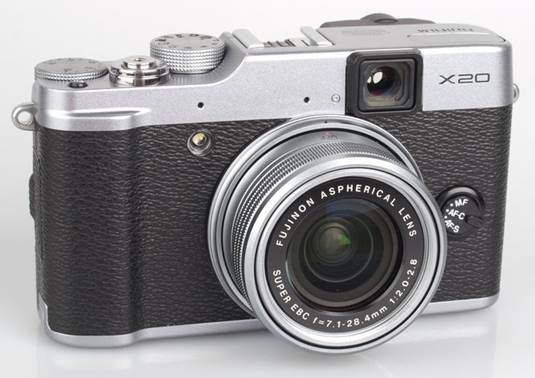
This
device’s body is also made of metal
This device’s body is also made of metal
and owns the similar design style like the previous X10, although it is black
and silver or all black version available. The lens features a zoom ring
surrounding it, which is manually controlled and can be used to turn on/ off
the device. The optical view with an electronic overlay is brought about by a
hybrid optical viewfinder.
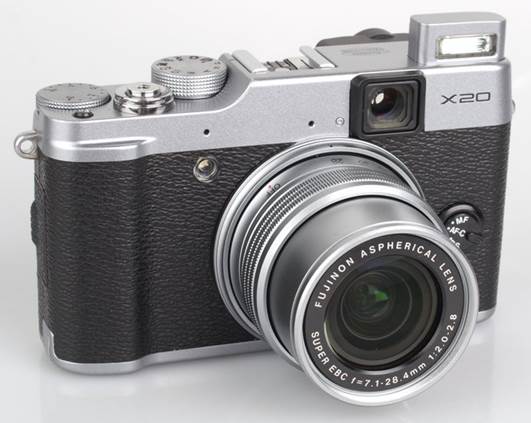
The
lens features a zoom ring surrounding it
The new sensor of this camera, the Hybrid
AF CMOS, with its phase detection gives improved focus speeds, and X-trans
sensor is equivalent to that it will be no longer an “EXR” sensor, which has
three modes: HR – Hi-res / DR – Dynamic Range (up to 1600%) / SN – low light /
low noise performance.
The X20’s sensor uses the same color filter
array as what has been introduced with the X-Pro 1, which is designed to reduce
the noise level and allows eliminating the antialiasing filter, which is believed
to bring more sharpness to the images than the sensor used in the X10. The
sensor is designed to perform better in the low light environment and show less
noise. The DR option is up to 400% for this model.
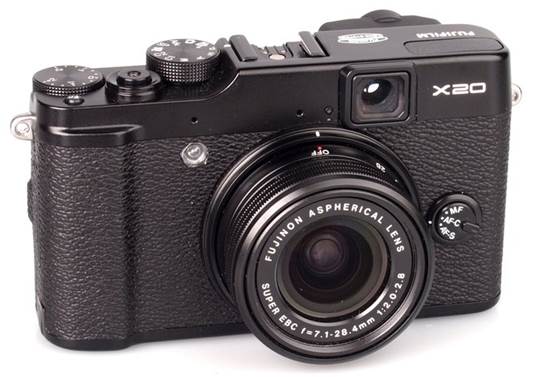
The
all black version
Technology
applied in this X20 is designed to remove the effects of diffraction and
aberration when using smaller apertures. As the result, the images are sharper
and in total, the Fujifilm has introduced over 50 enhancements in the X20
compared to the X10. The Fujifilm X20 shows the similar outlook and feeling as
the Fujifilm X100s but just half in price.
Key
features
·
12megapixel 2/3inch X-Trans CMOS II sensor
·
4x optical zoom lens, f/2.0-f/2.8, 28-112mm
equivalent
·
Optical image stabilisation
·
2.8inch screen, 460k dot
·
Advanced optical viewfinder with 'real time'
shooting data display
·
Full HD, 60fps video, with phase detection AF
·
12fps continuous shooting
·
49 Points Selectable AF
·
Manual modes, 14-bit RAW
·
In camera RAW converter
·
Manual focus with focus peaking
·
ISO100 - ISO12800
·
1cm super macro mode
·
Advanced Filters, 360 panoramic
·
Available in black or black and silver
Handling

On
the top of the camera, there is an exposure compensation button
The Fujifilm X20’s design reminds us of the
feeling and outlook of a traditional camera, but it is much more compact, built
in an optical viewfinder and the classic shutter release button with screw
thread. When using the camera, it features a very high-speed of shutter
response and its soft shutter sound also makes us think that it is an ideal
travel or street shooter camera. The build quality is great. The device’s body
is made of solid metal and there is also a rubber grip on the back side for you
to lay your thumb, as well as a rubber layer for the optical viewfinder
featuring the detection. We find the front side of the camera solid and its
hard texture around the metal zoom ring makes the users feel good and safe
holding the camera with two hands.
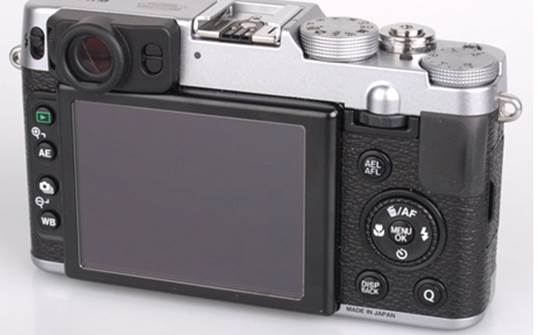
The
Q. menu button allows accessing into some settings at the back screen quickly
On the top of the camera, there is an
exposure compensation dial that allows you to adjust the exposure quickly,
although it might be possible that you would forget changing it and leaving it
set accidentally. The device has a Q. menu button which features the quick
access to a number of settings at the back screen. Fujifilm’s menu displays
many options about the images and settings, which are organized tidily and into
a color coded sections (this is a great improvement compared to the X10’s menu).
Pop-up flash is activated when using the manual switch at the back and it is
also easy to be turned off just by sliding it back to the original position. Using
the Fujifilm X20 under the intense sunlight condition can cause many
difficulties as the screen becomes hard to see – fortunately, the bright
sunlight mode can be used to compensate for the brightness and contrast of the
screen, which helps solving some problems, but under the brightest conditions,
it is better to use the optical viewfinder. The optical viewfinder provides a
85% coverage, and at the widest setting, it is possible to see the lens. The
viewfinder is covered by an electronic layer which tells you the focus point, shutter
and aperture speeds and changes the color depending on whether the focus has
been successfully locked.
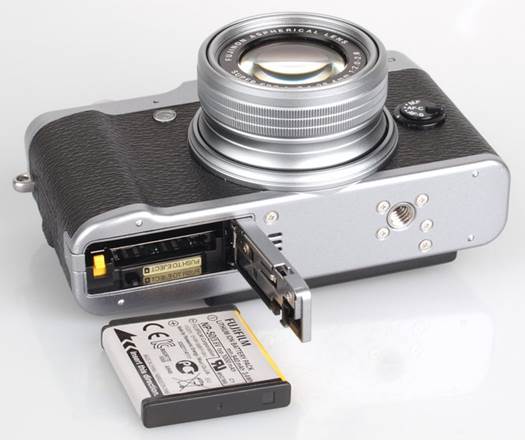
The
camera’s battery is rated at 270 shots
Battery performance reaches the 270 shots,
according to Fujifilm / CIPA testing, which is just an average rate, but it can
reach 700 shots when you deactivate the back screen / eye-detection sensor /
turn on the power-saving mode, and simply use the optical viewfinder.
We took some shots to check the camera’s
responsiveness, from switch on to first photo, shot to shot, focusing speed etc.
We also take some pictures and use their average to ensure the accuracy and
consistency of the test result, making it easier to compare with other cameras.
Fujifilm
X20
·
Shutter Response: <0.05
·
Wide - Focus / Shutter Response: 0.2
·
Full zoom - Focus / Shutter Response: 0.25
·
Switch on Time to Taking a Photo: 1.2
·
Shot to Shot without Flash: 0.7
·
Shot to Shot with Flash: 1.0
·
Continuous Shooting – JPEG (shots before slow
down): 11fps (11 shots)
·
Continuous Shooting – Flash: N/A
·
Continuous Shooting – RAW: 8fps (8 shots)
Sony
RX100
·
Shutter Response: 0.0
·
Wide - Focus / Shutter Response: 0.3
·
Full zoom - Focus / Shutter Response: 0.3
·
Switch on Time to Taking a Photo: 2.2
·
Shot to Shot without Flash: 0.9
·
Shot to Shot with Flash: 2.1
·
Continuous Shooting – JPEG (shots before slow
down): 7fps (speed priority mode, 15 shots)
·
Continuous Shooting – Flash: 1.6s
·
Continuous Shooting – RAW: 4fps (13 shots)